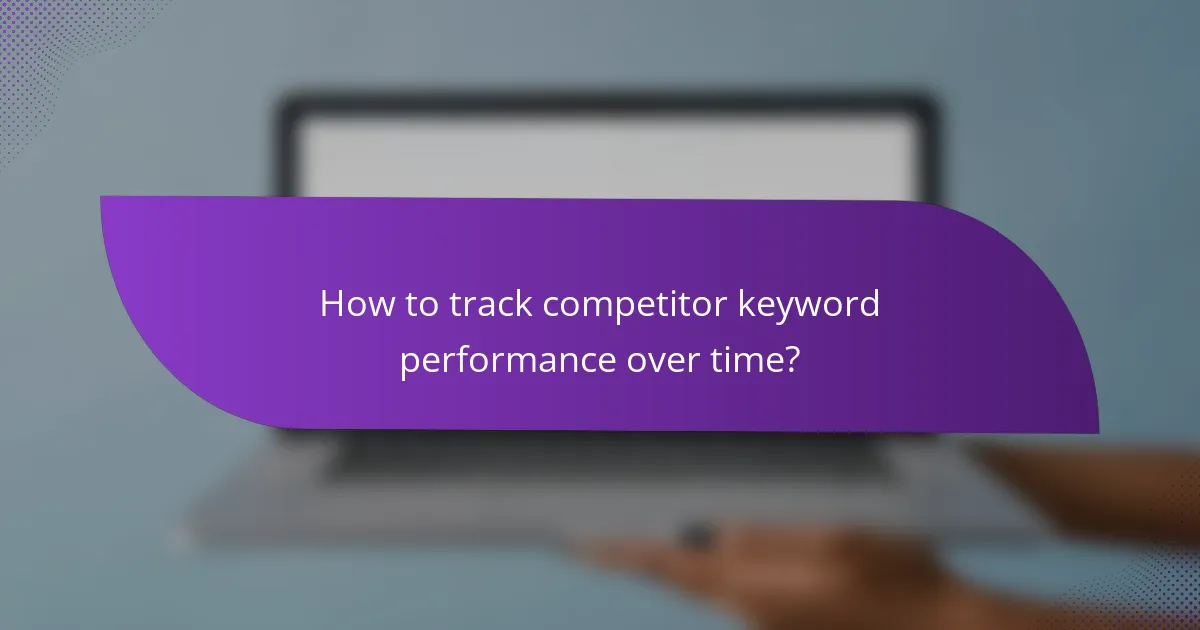Analyzing competitor keywords is essential for enhancing your own SEO strategy and identifying growth opportunities. By utilizing tools like SEMrush, Ahrefs, and SpyFu, you can uncover valuable insights into the keywords your competitors rank for, as well as their search intent. This analysis not only highlights gaps in your current strategy but also helps you focus on keywords that drive traffic and conversions.

How to analyze competitor keywords effectively?
To analyze competitor keywords effectively, start by identifying the keywords your competitors rank for and understand their search intent. This process helps you uncover opportunities to improve your own keyword strategy and content offerings.
Use keyword research tools
Keyword research tools are essential for discovering the keywords your competitors are targeting. Tools like SEMrush, Ahrefs, and Moz provide insights into keyword volume, difficulty, and trends. By entering a competitor’s domain, you can generate a list of keywords they rank for, along with valuable metrics.
When using these tools, focus on keywords with a balance of search volume and competition. Aim for long-tail keywords that may have lower search volume but higher conversion potential. This approach can help you identify niche opportunities that your competitors might be overlooking.
Conduct a content gap analysis
A content gap analysis involves comparing your content against that of your competitors to identify missing topics or keywords. Start by listing the keywords your competitors rank for that you do not. This will highlight areas where you can create new content or enhance existing pages.
To perform this analysis effectively, categorize the gaps by relevance and potential impact. Prioritize topics that align with your audience’s interests and your business goals. This will ensure that your new content not only fills gaps but also drives traffic and engagement.
Leverage SEO audit tools
SEO audit tools can help you assess your website’s performance compared to your competitors. Tools like Screaming Frog and Google Search Console provide insights into technical SEO issues, site speed, and mobile-friendliness. Understanding these factors can reveal why competitors may outrank you for certain keywords.
Regularly conducting SEO audits allows you to track improvements and adapt your strategy. Pay attention to metrics such as page load times and mobile usability, as these can significantly affect user experience and search rankings. Addressing these issues can enhance your overall keyword performance and visibility.

What tools are best for competitor keyword analysis?
The best tools for competitor keyword analysis include SEMrush, Ahrefs, and SpyFu. Each offers unique features that help you uncover valuable insights into your competitors’ keyword strategies, allowing you to refine your own SEO and PPC efforts.
SEMrush for comprehensive analysis
SEMrush is a powerful tool for conducting in-depth competitor keyword analysis. It allows you to explore your competitors’ organic and paid keywords, providing data on search volume, keyword difficulty, and trends over time.
To get started, enter a competitor’s domain into SEMrush. You’ll receive a detailed report that highlights their top-performing keywords, estimated traffic, and even ad copies. This information can guide your content strategy and help identify gaps in your own keyword targeting.
Ahrefs for backlink insights
Ahrefs excels in providing insights into competitor backlinks, which are crucial for understanding their keyword rankings. By analyzing the backlinks pointing to your competitors’ pages, you can identify which keywords are driving traffic and how you might replicate their success.
Using Ahrefs, input a competitor’s URL to access their backlink profile. Look for high-authority sites linking to their content, as these can indicate valuable keywords. Focus on acquiring similar backlinks to enhance your own keyword performance.
SpyFu for PPC keyword tracking
SpyFu specializes in tracking pay-per-click (PPC) keywords, making it an excellent choice for businesses focused on paid advertising. It reveals the keywords your competitors are bidding on, along with their ad spend and performance metrics.
To utilize SpyFu, enter a competitor’s domain and review their PPC history. This will show you which keywords are most profitable for them. Use this data to optimize your own PPC campaigns, ensuring you target keywords that yield a strong return on investment.

How to interpret competitor keyword data?
Interpreting competitor keyword data involves analyzing the keywords that your competitors rank for to identify opportunities and gaps in your own strategy. This process helps you understand which keywords drive traffic and conversions, allowing you to refine your SEO efforts effectively.
Identify high-volume keywords
High-volume keywords are those that attract significant search traffic, making them valuable for your SEO strategy. Start by using tools like Google Keyword Planner or SEMrush to find keywords that competitors rank for with substantial search volumes, typically in the hundreds or thousands per month.
Focus on keywords that align with your niche and have a good balance of search volume and relevance. For instance, if your competitor ranks for “best running shoes,” consider targeting variations like “top running shoes for marathons” to capture specific audience segments.
Analyze keyword difficulty scores
Keyword difficulty scores indicate how challenging it is to rank for a specific keyword based on competition. Tools like Ahrefs and Moz provide these scores, which typically range from 0 to 100, with higher numbers indicating more competition.
When analyzing difficulty, aim for keywords with a score that matches your site’s authority. If your site is relatively new, focus on keywords with lower difficulty scores, perhaps in the 20-40 range, to increase your chances of ranking higher.
Assess search intent behind keywords
Understanding search intent is crucial for selecting the right keywords. Search intent can be categorized into informational, navigational, transactional, and commercial investigation. For example, a keyword like “buy running shoes” indicates a transactional intent, while “how to choose running shoes” suggests informational intent.
Align your content with the intent behind the keywords you target. If a keyword indicates a desire to purchase, ensure your landing page includes clear calls to action and product information. Conversely, for informational keywords, provide valuable content that answers users’ questions effectively.

What are the benefits of analyzing competitor keywords?
Analyzing competitor keywords provides valuable insights that can enhance your online visibility and marketing effectiveness. By understanding which keywords drive traffic to competitors, you can refine your own strategies to capture a larger share of the market.
Improved SEO strategy
Utilizing competitor keyword analysis can significantly enhance your SEO strategy. By identifying high-ranking keywords that your competitors are targeting, you can optimize your content to rank for similar terms, improving your organic search visibility.
Consider using tools like SEMrush or Ahrefs to uncover keywords that are driving traffic to your competitors’ sites. Focus on keywords with moderate competition and reasonable search volume to increase your chances of ranking well.
Enhanced content creation
Competitor keyword analysis informs your content creation process by highlighting topics that resonate with your target audience. By understanding what keywords competitors rank for, you can create relevant, engaging content that meets user intent.
For example, if a competitor’s blog post on a specific topic ranks highly, consider producing a more comprehensive or updated version. This approach not only helps you capture traffic but also positions your brand as a thought leader in your niche.
Better PPC campaign targeting
Analyzing competitor keywords can optimize your pay-per-click (PPC) campaigns by identifying effective keywords that convert. By understanding which keywords your competitors bid on, you can allocate your budget more efficiently and improve your ad performance.
Focus on long-tail keywords that may have lower competition but higher conversion rates. Regularly review competitor ad copy and landing pages to refine your own messaging and targeting strategies, ensuring that you stand out in the crowded marketplace.

What criteria should you consider when selecting tools?
When selecting tools for analyzing competitor keywords, consider integration with existing workflows, cost-effectiveness, and user interface. These criteria ensure that the tools not only fit within your current processes but also provide value without overwhelming complexity or expense.
Integration with existing workflows
Choosing tools that seamlessly integrate with your current workflows is crucial for efficiency. Look for software that can connect with your existing platforms, such as content management systems or analytics tools, to streamline data sharing and reporting.
For example, if you use Google Analytics, a keyword analysis tool that can pull data directly from it will save time and reduce manual work. Evaluate how well the new tool will mesh with your established systems before making a decision.
Cost-effectiveness of tools
Cost-effectiveness is a key factor when selecting keyword analysis tools. Assess not only the upfront costs but also the potential return on investment. Tools that offer tiered pricing or free trials can help you gauge their value before committing financially.
Consider whether the tool provides features that justify its cost. For instance, a tool priced at USD 100 per month may be worthwhile if it saves you significant time or uncovers valuable insights that lead to increased traffic.
User interface and ease of use
The user interface and overall ease of use of a tool can significantly impact your team’s productivity. A clean, intuitive design allows users to navigate the tool without extensive training, which is especially important for teams with varying levels of technical expertise.
Before finalizing your choice, take advantage of demos or trial periods to assess the user experience. A tool that is easy to use can lead to quicker adoption and more effective keyword analysis, ultimately enhancing your competitive strategy.

How to track competitor keyword performance over time?
Tracking competitor keyword performance over time involves monitoring their rankings and traffic for specific keywords to understand their strategies and effectiveness. This process helps identify trends, opportunities, and areas for improvement in your own keyword strategy.
Set up regular reporting
Establishing a routine for reporting on competitor keyword performance is crucial for gaining insights. Aim to generate reports weekly or monthly, depending on your industry dynamics and the frequency of changes in search rankings. Regular updates allow you to spot trends and adapt your strategy accordingly.
Consider using automated tools that can compile data from various sources, such as search engines and analytics platforms. This can save time and ensure consistency in your reporting process.
Utilize rank tracking features
Many SEO tools offer rank tracking features that allow you to monitor how your competitors rank for specific keywords over time. These tools can provide insights into fluctuations in rankings, which can indicate shifts in strategy or algorithm changes. Look for features that allow you to compare multiple competitors simultaneously.
When selecting a rank tracking tool, consider factors like ease of use, data accuracy, and the ability to track local rankings if your market is geographically focused. Tools like SEMrush, Ahrefs, or Moz can be effective for this purpose.
